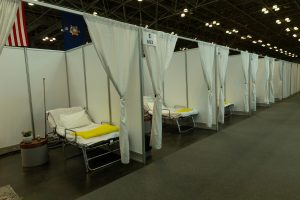November 2021
Inside This Issue
2022 Manuals and Workplace Violence & Resuscitation Standards:
There are several bits of news we will discuss from this month’s edition of Perspectives, but nothing significantly burdensome if you are pressed for time. Perhaps the most important news is the announcement that the 2022 manuals will soon be posted to the E-Edition. We did take a look in preparation for our newsletter and indeed they are now posted. We believe it is advantageous to verify you have captured everything that is new that you will be held accountable for in 2022.
 The E-Edition does provide a filter icon (it looks like a funnel) that you can apply as you visit the link, and this will only display those chapters, and elements of performance that are actually new for 2022. You will see that there are changes in the APR, EC, HR, LD, LS, PC, and PI chapters. Each of these changes have been described in earlier issues of Perspectives and the Patton Post in 2021.
The E-Edition does provide a filter icon (it looks like a funnel) that you can apply as you visit the link, and this will only display those chapters, and elements of performance that are actually new for 2022. You will see that there are changes in the APR, EC, HR, LD, LS, PC, and PI chapters. Each of these changes have been described in earlier issues of Perspectives and the Patton Post in 2021.
The two largest program issues to validate are ready for implementation are the new workplace violence standards (EC, HR, LD) and the resuscitation standards (PC, PI). There are also changes unrelated to workplace violence or resuscitation in APR.04.01.01, modifying how you select and change ORYX measures, and one change in the LS chapter on the spare sprinkler head issue.
There are three significant implementation issues for the new workplace violence standards (WPV). The first is EC.02.01.01, EP 17 which requires a documented, annual worksite analysis of security risks, incidents, policies, training and environmental design in contrast with best practices, law, and regulation.
The second WPV implementation issue is HR.01.05.03, EP 29 creating a requirement for training in prevention, recognition, response (e.g., de-escalation) and reporting of WPV issues. This training should be at the time of hire, annually and whenever changes occur.
The third WPV implementation issue is LD.03.01.01, EP 9 which requires leadership of your WPV program led by a designated individual and developed by a multidisciplinary team.
The new resuscitation standards also have a required training component at PC.02.01.11, EP 4. This training differs from the WPV training as it is needed at the time of hire, “periodically thereafter,” and when staff responsibilities change.
In addition, TJC has already posted a standards FAQ further explaining this new training requirement identifying that it is not just the certifications like BLS or ACLS, but that training must include institution specific training to promote staff preparedness.
 The second new resuscitation requirement is in three (3) elements of performance at PC.02.01.20. These three new elements of performance address policies, procedures, and protocols based on scientific literature, for post cardiac arrest care. TJC also addresses the terms policies, procedures, and protocols in the new FAQ, basically stating that the format of your content, either policy, procedure, or protocol or a combination, is up to the individual hospital.
The second new resuscitation requirement is in three (3) elements of performance at PC.02.01.20. These three new elements of performance address policies, procedures, and protocols based on scientific literature, for post cardiac arrest care. TJC also addresses the terms policies, procedures, and protocols in the new FAQ, basically stating that the format of your content, either policy, procedure, or protocol or a combination, is up to the individual hospital.
The new resuscitation requirements are further addressed in PI.01.01.01, EP 10 which calls for the collection of data on cardiac arrests and the outcomes of resuscitation, and PI.03.01.01, EP 22 which requires an interdisciplinary committee to review cases and data to identify practice or system improvements. Further explanation of what TJC is looking for is also detailed in the same new FAQ, found in the PC chapter.
 As you review the PI changes you will also note changes at PI.02.01.01 and PI.04.01.01 which are unrelated to the resuscitation standards, but rather how you select the PI priorities in your plan and the use of improvement tools or methodologies to improve performance.
As you review the PI changes you will also note changes at PI.02.01.01 and PI.04.01.01 which are unrelated to the resuscitation standards, but rather how you select the PI priorities in your plan and the use of improvement tools or methodologies to improve performance.
In conclusion, do print and circulate the new content to your identified implementation leaders and obtain a status report on implementation efforts in place for January 2022.

Influenza Immunization:
The November issue of Perspectives also contains an update on the measure specifications for influenza vaccination of hospitalized patients to better align with CDC recommendations. There are allowable exclusions for influenza vaccination and this now includes symptomatic suspected or confirmed COVID-19.
Non-Ventilator Hospital Acquired Pneumonia:
 Perspectives also has an article revisiting a Quick Safety Issue 61 that TJC published in September on non-ventilator hospital acquired pneumonia (NVHAP). They state that an estimated 1/100 hospitalized patients are affected by NVHAP and it is not currently measured by CMS, NDNQI or CDC. The Quick Safety suggests interventions that might help prevent the incidence recommends some safety interventions that hospitals can take.
Perspectives also has an article revisiting a Quick Safety Issue 61 that TJC published in September on non-ventilator hospital acquired pneumonia (NVHAP). They state that an estimated 1/100 hospitalized patients are affected by NVHAP and it is not currently measured by CMS, NDNQI or CDC. The Quick Safety suggests interventions that might help prevent the incidence recommends some safety interventions that hospitals can take.
Human Resource Scoring Guidance:

This month’s Consistent Interpretation column discusses the human resource standard HR.01.01.01 and the guidance section for EP 2 is worth taking a look at. In the guidance section, TJC shares information and scoring advice provided to surveyors, and this clarity is sometimes helpful in both meeting the requirement and avoiding unnecessary work. This month we noted the following advice to surveyors:
- Limit the primary source verification of licensure to only the time of hire and the most recent renewal period,
- Organizations are not required to maintain redundant HR files for contracted staff. Surveyors may request specific files which can be provided by the contractor for verification,
- Do not request evidence of licensure, certification, or education verification for contracted staff when using a Joint Commission accredited or certified contractor.
The issue of contractors and keeping up with Joint Commission requirements for licensure, training documentation, and competency validation is frequently challenging.
While TJC explains, there is no mandate that organizations maintain redundant files, we would suggest that our readers test the process to verify the contractor is maintaining such files to your specifications and has the ability to transmit a copy of the required documentation upon request for your HR session.
EC/LS Most Frequently Cited:
The lead article in this month’s EC News is about the most frequently cited element of performance level EC and LS findings, although they also identify the 2021 entire top 10, which includes three clinical standards. The three clinical findings and their position on the top 10 list include:
- #4: 02.01.01. EP 1: General IC findings from dirt, adhesive residue or any potential source of contamination.
- #5: 06.01.01, EP 3: Medication administration issues, most often of which are problems with medication titrations.
- #7: 02.02.01, EP 2: Use of standard precautions and PPE. In this era of Covid, this issue has taken on higher importance than it might have in the past.
The EC and LS findings should not surprise readers of this newsletter. They are so to speak the “usual suspects” that TJC has been finding for many years.
- #1: 02.06.01, EP 1: The official language is that interior spaces meet the needs of patients, but as we have written previously, this is a catch all EP, where just about anything wrong in the physical environment can be scored, from ligature hazards to a stained ceiling tile to a torn mattress cover.
- #2: 02.01.35, EP 4: Piping for sprinklers is not used to support any other item. This one just won’t go away, as there are problems made years ago by staff or vendors, and there appears to be a continuing problem with people using those sprinkler pipes as supports for other above the ceiling items. An above the ceiling inspection program is needed to find the long-standing problems and a follow up inspection whenever someone is working above the ceiling laying cable or ducts is needed to help prevent this from continuing.
- #3: 02.05.05, EP 6: This concerns what are called non high risk utility systems and the requirement is to inspect, test and maintain them appropriately. As with many things from a maintenance perspective the manufacturers guidance is essential.
- #6: 02.05.01, EP 9: Label utility systems. A common source of error with this EP is unlabeled breakers in the on position in an electric circuit breaker utility box, or failure to label the fire alarm circuit in red.
- #8: 02.01.10, EP 5: The hospital meets all other life safety code extinguishing requirements. This is another catch all EP that could be a blocked fire extinguisher to an extinguisher hung at the wrong height.
- #9: 02.02.01, EP 5: The hospital minimizes risks with hazardous chemicals. The so called “eye wash” EP.
- #10: 02.01.10, EP 14: Penetrations through walls and floors. Similar to #2 above, hospitals need to look above the ceiling for current penetrations that were never sealed, or the sealant has dried and fallen out, or someone has just been working above the ceiling, drilled through a wall or floor and failed to seal the penetration when the work was completed. Again, a rigorous inspection program to find the current problems is needed, and a post work inspection process when someone has been working above your ceilings is needed to prevent creating new problems.
We would encourage our readers to circulate this EC News article and inquire about your preparedness on these issues. When we review TJC reports we don’t see a lot of esoteric new findings. We see these issues TJC is warning us about over and over again. If hospitals can get a handle on these very frequently scored standards, they will be much better prepared for survey.

Snow Mitigation Efforts:
As much as we may not want to think about it, winter is coming and along with it in many parts of the country there may be snow. EC News has an article this month on planning out your snow mitigation effort that includes chain of command or continuity of operations considerations, competency issues for certain types of snow removal machinery, and activation of the emergency operations plan.
If your organization is in snow country, we would encourage you to circulate this, along validation that the recommendations contained have been incorporated in your organizations planning.
 Alternate Care Site Guidance:
Alternate Care Site Guidance:
Over the past two years, many organizations have probably gotten much more experienced at creating alternate care sites than they might have earlier. EC News has a discussion about the recent ASHE meeting where there was a session on “Converting Spaces for Surge Capacity.” Insights from that session and some examples of how organizations converted some existing spaces are discussed.
Perhaps most valuable is a link to a new, free guidebook from ASHRAE called the Alternative Care Site HVAC Guidebook. This can be downloaded free of charge using the following link.
 USP Chapter 797:
USP Chapter 797:
The new chapter that was delayed at the end of 2019 due to appeals has been redrafted and published. In many respects it should look familiar to those who had read the copy planned in 2019.
One change that had been part of the appeal process is they did allow for longer beyond use dating in some instances that likely will be useful to sterile compounding vendors and some really large hospital organizations, but not your average institution.
Issues that had been described in the 2019 version which remain today is for more frequent surface sampling of the compounding environment and more frequent media fill and finger-tip sampling. Media fill and finger-tip sampling will move from an annual retest to an every-6-month test in most organizations.
Those few organizations that prepare what are now called Category 3 sterile compounds will require media fill and finger-tip testing every 3 months. Surface sampling is moving from an every-6-month requirement to a monthly requirement.
These additional workloads, in combination with the continuation of the every-6-month air sampling of the sterile compounding environment will make many of our readers want to reconsider their options of doing Category 3 sterile compounding in house or contracting the process out to a vendor. Many organizations currently use their certifier to perform the every-6-month testing, but monthly tests will have cost considerations and certifiers may not be able to handle the additional workloads.
An official start date for implementation of the latest version of USP Chapter 797 has not been determined, but it is likely to take effect sometime within the coming calendar year. When it does take effect, track record requirements for accrediting organizations begin. Our advice is not to wait until the deadline before having a plan in place.
If you plan to use your certifier to perform additional testing, verify they have the willingness and capability to do so, and that pricing is acceptable to your organization. If you plan to perform internal surface sampling, the USP chapter will require an area sampling diagram, standard operating procedures, and accrediting bodies are going to expect competencies for those who perform, incubate, count colonies, and interpret the results of sampling. Laboratory support will also be needed as any air or surface samples that exceed action levels will need to be identified at a genus level.
Our advice is to start your planning now as there are likely to be many decisions to be made and hurdles to be overcome to get this expanded monitoring up and running. It is always best to start the process, overcome the hurdles, and redesign as needed, prior to the required effective date.
 Hospice QSO Memo:
Hospice QSO Memo:
There were no new QSO memos to the hospital industry posted this month, however there was one new QSO 22-01 directed to the hospice industry that caught our attention. It is only two (2) pages long but it describes planned “enhancements” to the oversight of accrediting organizations that perform deemed status surveys of hospice providers.
We noted that CMS desires hospice survey teams be more multidisciplinary, be clear of any conflicts of interest, to have accrediting body surveyors use CMS surveyor training, and perhaps most surprising is to have accrediting body surveyors use the CMS form 2567 to document their findings. Form 2567 has been in use since the days when typewriters were prevalent and creating plans of correction continues to pose challenges to organizations who are used to online fillable forms or word processing applications. We will have to see if these “enhancements” migrate to other CMS deemed status programs.
Consultant Corner
Dear Readers,
Just a reminder, if you are due for survey next year or in 2023, we are scheduling mock surveys now.
Contact us today at ExpertAdvice@PattonHC.com to get on the schedule!
Jennifer Cowel, RN MHSA
JenCowel@PattonHC.com
Kurt Patton, MS RPh
Kurt@PattonHC.com
John Rosing, MHA
JohnRosing@PattonHC.com
Mary Cesare-Murphy, PhD
MCM@PattonHC.com
